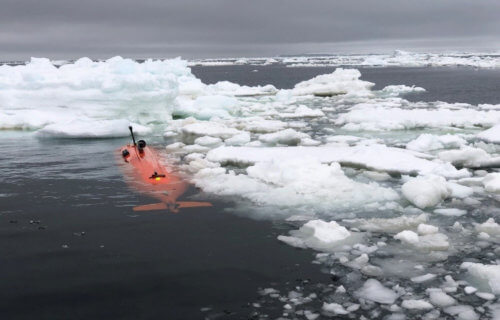GOTHENBERG, Sweden — For many places on Earth, snow and ice have become a rare sight. When those wintry scenes start melting in the Antarctic, you know there’s trouble. A new study finds the infamous “doomsday glacier” in the Antarctic is melting faster than experts initially feared. Researchers from the University of Gothenburg say warm water is reaching the mighty Thwaites Glacier at an alarming rate, speeding up fracturing and weakening in the massive structure.
Roughly the size of Great Britain, scientists call it one of the “most important” glaciers in the world. There is enough water locked inside to swell the oceans by more than half a meter (roughly two feet). Melting from Thwaites Glacier already accounts for four percent of world sea level rise each year.
Getting underneath the glacier
Study authors collected observations using the unmanned submarine “Ran,” which made its way under the remote glacier in the West Antarctic Ice Sheet. Data included strength, temperature, salinity, and oxygen content of the ocean currents that pass beneath Thwaites.
“These were the first measurements ever performed beneath Thwaites glacier,” lead author Professor Anna Wahlin says in a university release.
Researchers identified a deep connection to the east through which deep water flows from Pine Island Bay. Scientists say they thought this route was blocked by an underwater ridge. The study, appearing in the journal Science Advances, also examines the transport of heat in one of the three channels that leads warm water from the north.
“The channels for warm water to access and attack Thwaites weren’t known to us before the research,” adds co-author Dr. Alastair Graham from the University of Southern Florida. “Using sonars on the ship, nested with very high-resolution ocean mapping from Ran, we were able to find that there are distinct paths that water takes in and out of the ice shelf cavity, influenced by the geometry of the ocean floor.”
Ice shelf in hot water?
Calculations show nearly 50 cubic miles of ice is melting a year. That’s almost as much as from the entire ice shelf. It has a large effect locally and suggests the glacier is losing its stability over time. Large amounts of meltwater is also flowing north, away from the front of the glacier.
Variations in salinity, temperature, and oxygen indicate different water masses meet and mix with each other. The findings shed fresh light on glacier melting processes. These observations also reveal warm water approaching from all sides on “pinning points” — critical locations connecting to the seabed which secure the ice shelf. Melting may lead to instability and retreat, with the upstream glacier flowing off the land.
“This work highlights that how and where warm water impacts Thwaites Glacier is influenced by the shape of the sea floor and the ice-shelf base as well as the properties of the water itself,” says Dr. Rob Larter of the British Antarctic Survey.
“The successful integration of new sea-floor survey data and observations of water properties from the Ran missions shows the benefits of the multidisciplinary ethos within the International Thwaites Glacier Collaboration.”
Why is Thwaites the ‘doomsday glacier’?
Thwaites is like a keystone right in the center of the West Antarctic Ice Sheet. The vast basin contains more than three meters of additional potential sea level rise. The study is the most detailed survey of this formation to date.
“The good news is that we are now, for the first time, collecting data that is necessary to model the dynamics of Thwaite’s glacier. This data will help us better calculate ice melting in the future,” Prof. Wahlin explains. “With the help of new technology, we can improve the models and reduce the great uncertainty that now prevails around global sea level variations.”
Understanding what is happening to Thwaites is essential for scientists to be able to predict future sea level rise accurately. The ice in Antarctica holds 90 percent of the world’s fresh water.
“This was Ran’s first venture to polar regions and her exploration of the waters under the ice shelf was much more successful than we had dared to hope. We plan to build on these exciting findings with further missions under the ice next year,” Professor Karen Heywood from the University of East Anglia concludes.
SWNS writer Mark Waghorn contributed to this report.
